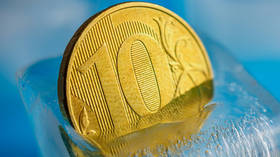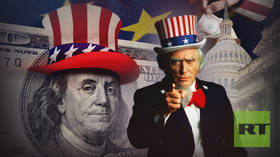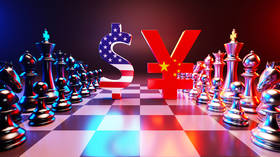Do the new US sanctions mark Russia’s final divorce with the dollar?
Washington’s policies are simply pushing Moscow further along a path it has already embarked on
The endless parade of Western sanctions on Russia barely makes the news anymore. But this week the US Treasury did manage to conjure up something that has generated attention.
In what may be the most ambitious package since the initial wave back in February 2022, the American authorities greatly increased the scope for applying secondary penalties on foreign financial institutions found working with restricted Russian entities, and placed the Moscow Exchange and its clearing house under blocking sanctions, among other measures. The exchange subsequently announced that it was suspending all settlements in dollars and euros. It’s the latter that is the most interesting and has elicited the most chatter.
But, before pursuing this train of thought, let’s dig into the nitty-gritty a little bit and sort out what is actually going to happen to currency trading in Russia.
How currency trading actually works
To trade currencies on the Moscow Exchange, banks and other players send ‘buy’ and ‘sell’ bids to the exchange throughout the day. These buyers and sellers do not trade with each other directly but rather though the exchange’s clearing house, the National Settlement Center (NSC). In the evening, these trades would be settled by the clearing center, which had correspondent accounts in foreign banks for each currency. In other words, currency trading on the exchange involved the participation of foreign banks. It was not an enclosed system such as trading in Russian stocks (where the shares of Russian companies are bought and sold in rubles by investors without the involvement of any foreign entity).
It is exactly this ability to clear currency trades that has been taken away by the new sanctions. American correspondent banks will now be barred from carrying out settlements with the NSC. From a technical standpoint, it is actually the sanctions against the NSC – rather than the exchange itself – that are most sensitive.
The Russian central bank has stated that currency trading will henceforth take place over-the-counter (OTC), meaning in decentralized fashion. But what is important to understand is that this is hardly a radical move – currency markets across the globe are conducted OTC, so this will in a sense merely bring Russia in line with standard practice. Russia was unusual in that currency trading primarily took place on a centralized exchange, whereas generally currencies are traded through a decentralized network of banks, a system much more flexible than relying on an exchange. The New York Stock Exchange, for example, does not host currency trading.
Moving to OTC doesn’t mean that currency trading in Russia is going to resemble every other currency market. But it does provide a bit of a context to understand that this shift itself isn’t particularly radical. In fact, Russia is already essentially halfway there. According to the latest report from the Bank of Russia, 58% of currency trading in the country takes place off-exchange.
The central bank will use as its official rate some sort of average based on information obtained each day from banks. The new arrangement will almost certainly be a bit messy, especially at first: spreads will be wider, liquidity lower, transparency reduced, and price discovery in general harder. Transactional costs will be higher, a sensitive point for importers, for example. The market will be more prone to manipulation, and some analysts have posited that different exchange rates could emerge: an official central bank rate, the rates offered by various banks and a black-market, ‘street’ rate. However, on Thursday the Bank of Russia provided assurances that the exchange rate would remain market-driven and unified.
Where the ruble might be headed
What exactly will happen to the ruble exchange rate remains to be seen, but there are strong grounds to believe that it will not move significantly from current levels. After all, the fundamental supply-demand structure of the market will not change in any dramatic way. The ruble’s exchange rate is determined by supply and demand from foreign trade and not on which platform trading takes place. Early indications are the market will largely shrug off the closure of dollar and euro exchange trading.
There is another important angle to consider here. Formally, only American correspondent banks have been barred from working with the NSC. But experience has shown that once a Russian entity falls under US sanctions it is seen as radioactive elsewhere and other institutions steer clear. The increasingly bellicose rhetoric about secondary sanctions emanating from Washington will surely only exacerbate this tendency.
Therefore, it’s entirely possible that the correspondent banks of other countries – even friendly ones – will fear secondary sanctions and will pull back as well. If and how the Chinese will continue to work with the NSC is a major question. China may stick with its pattern of stepping in where the West departs and playing the dominant role in the Russian forex market. This seems likely, given recent trends. In such a scenario, it wouldn’t be the large Chinese banks getting involved – they are too wary of secondary sanctions – but smaller ones.
In any case, the Russian central bank has declared the yuan, already the most-traded currency in Moscow, with a 54% share in May, the country’s main foreign currency. The yuan-ruble rate will become a benchmark for market participants and will help set the trajectory for other currency pairs, including the euro and dollar. In other words, market participants will rely on the cross rate of yuan-ruble and yuan-dollar and yuan-euro to determine the fair market rate. It’s also possible that in some conversions the yuan could find itself in the previously almost-unthinkable role as the pivot currency in ruble-dollar conversions: rubles would be exchanged into yuan and then from yuan to dollars, for example.
Implications for a changing world
Let’s now step back a bit and survey the big picture. What we see is yet another manifestation of the strange incongruity in Washington’s approach. It is ostensibly in America’s interest to stem the tide of dedollarization, but instead it is degrading the greenback and pushing it even further out of the trade of a major global power.
Careful observers of Russia’s long experience with sanctions will notice a certain pattern. A restriction will be imposed that causes a disruption in the way a certain economic process was carried out. Russia is temporarily inconvenienced and endures certain negative effects, with varying degrees of short-lived panic. Then it adapts and emerges more resilient and stronger. And with new infrastructure free of the West to show for it. This case will hardly be different.
In fact, the adjustment process might be a lot more painless than imagined. When asked about the closure of dollar and euro trading on the exchange on Thursday, one major Russian commodity exporter told Reuters: “We don’t care because we have yuan.”
Furthermore, in its desperation to somehow stifle Russia’s economy and isolate Moscow, it is simply catapulting Russia toward the type of self-sufficiency and sovereignty the Russian government may have dreamed about but could have never have implemented on its own. And this ultimately makes Russia stronger.
As case in point, it will now become more difficult for Russian capital to be whisked out of the country, which will have the effect of boosting investment at home. The initial rounds of sanctions established that to be the case; the latest measures will only enhance this trend. The Russian government has for years been fighting to bring capital back home and have it invested domestically. The Biden administration has proven an unmatched ally in that endeavor. As a corollary, Russians will find it much more difficult to buy assets abroad and to hold money outside of Russia. This also means more investment at home.
Meanwhile, the latest sanctions, which also targeted seven Chinese and Hong-Kong-based companies for shipping millions of dollars of possible dual-use goods to Russia, are yet another sign of the US’ willingness to confront China. The Chinese have so far tread carefully in their dealings with both the US and Russia, but this flagrant violation of its sovereign right to do business with whomever it chooses has again rankled Beijing. Chinese Foreign Ministry spokesman Lin Jian called for the US to “immediately stop slapping illegal unilateral sanctions” due to China’s economic ties with Russia. Beijing will avoid rash steps and will pick its battles, but there is no question of capitulation to Washington.
And, finally, this is yet another step on the inexorable march toward a multipolar world. The expanded authority to impose secondary sanctions is a violation of sovereignty of such staggering boldness that their actual use can only presage the crack-up of the system itself. US hegemony seems to have entered its self-immolation phase. There would have been better ways, to put it mildly, than blunt confrontation to keep the show going at least a while longer.
The French monarch Louis XIV sought to maintain control over the aristocracy by bringing them into the luxurious and warm embrace of a comfortable court life at Versailles. The ploy had a certain logic to it: kept close at hand and occupied by frivolous matters of court life, France’s nobles posed less of a threat and failed to develop the resiliency and resourcefulness that a confrontational approach by the monarch would have necessitated.
The US could have opted for a similar approach of granting generous access to the dollar-centered system even to foes and scrupulously preserving that access even in the midst of competition. This would have kept even adversaries in the US orbit and comfortable and complacent about the status quo. Without a pressing need, few countries would have embarked so determinedly on the path of building a whole new infrastructure and revamping trade ties. But such an approach would have required far more foresight than is found in Washington these days.
In the short term, Russia will, somewhat paradoxically, seek workarounds to maintain its ability to convert between dollars and rubles. But at the same time, the ground is being laid for the yuan to play an even more prominent role in Russia’s economy. And it hardly bears mentioning that other countries are taking notice. This trend toward a new financial order is one that the US, in its blind zeal to punish Russia, keeps stumbling into new ways to encourage.









Comments are closed.